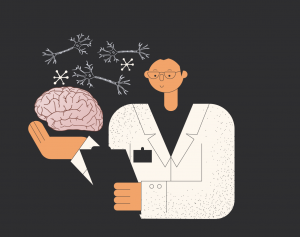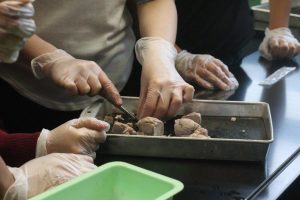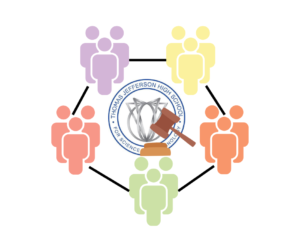Neuroscience lab conducts experiments on volunteer human subjects
The simulated urban environment shown to subjects in Liu and Ribeiro’s experiment. Each subject would freely explore in the simulation before moving on to a scavenger hunt, where they were told to find objects. “Our two environments are nature and urban scenarios. [In] our nature environment, people were definitely more attentive in the goal directed trial level,” Liu said. “But in the urban [environment], it seems that people were attentive both ways.”
May 2, 2023
To assist seniors in the Neuroscience lab, Jefferson students can volunteer to participate in their lab experiments as human subjects.
A graduation requirement here at Jefferson, all seniors must craft and work on their own research project throughout the whole year, chosen based on their interests in junior year. Jefferson provides 13 different lab options, including Biotechnology and Life Sciences, Astronomy and Astrophysics, Quantum Physics and Optics, and Neuroscience.
Similar to a biology lab, the Neuroscience lab requires many hands-on, interactive experiments. Seniors in the Neuroscience lab typically use one of the following subjects: crayfish, fruit flies, or humans. Senior Elina Liu and her partner Lucas Ribeiro decided to conduct their experiments on humans.
“For human subjects, the process is a little more complicated because you’re working with people who can interact with you and [it’s important to] make sure that everything’s safe,” Liu said. “You need to undergo a lot of regulations with the international review board to make sure your experiment is not causing harm to the human subjects.”
The human subjects were student volunteers, all grades being welcome to participate in exchange for service hours. Freshman Jessica Chen participated in seniors Ethan Valentine and Maanasa Schwartzkopf’s experiment, which examined the effect of biodiversity on stress levels.
“A lot of studies lately have pushed the benefits of being around animals and wildlife in improving anxiety, so we wanted to go ahead and test what is known as the biophilia hypothesis,” Schwarzkopf said. “Basically, the idea that being around nature makes people happy, on a small scale.”
Chen was told to look at types of fish tanks, during which the seniors measured her stress levels.
“First, I had to look at an empty tank. I immediately zoned out, because there was nothing to look at,” Chen said. “Secondly, I looked at plants, and there were rocks as well. Again, I don’t think it really did anything [to my brain] so I counted the rocks and the plants. Finally, I looked at fish and that was more entertaining.”
Liu and her partner Ribeiro’s experiment, “The Effect of Goal Orientation and Environmental Composition on Pupillary Unrest and Blink Rate”, measures human attentiveness in different simulated scenarios.
“Essentially, we’re just putting people in front of a simulated screen. It’s like a first-person walking environment where they’re able to explore and navigate,” Liu said. “For ten minutes, we have them explore [freely]. Then for the next ten minutes, we [tell] them to use a scavenger hunt, [where] they have to find objects.”
Liu’s experiment uses pupillary unrest and blink rate, measures of human attentiveness, to compare concentration in the freestyle and scavenger hunt simulation scenarios. In order to conduct these advanced experiments, the Neuroscience lab requires high quality equipment .
“We have a lot of access to a lot of expensive equipment,” Liu said. “For my project, I’m using these Pupil Core camera glasses that you put on human subjects to measure their pupil information. We can see your pupil oscillations, the diameter of your pupil, and how many times you blink.”
Liu and her partner Ribeiro are currently in the process of data analysis, using an ANOVA test as well as a t-test in order to calculate significance. The next step would be to examine the results.
“[You have to make sure] you’re recording everything [throughout the whole process], because it’s really helpful for years after us to be able to track what we did, so they don’t have to repeat any work,” Liu said.
Using human subjects comes with its fair share of risks due to its unpredictability, but can yield interesting results, causing it to be a rewarding experience.
“I wouldn’t trade [humans] for flies, that’s for sure,” Schwarzkopf said. “The fact that results are applicable to humans is fun, and it made me feel more hands on [with the experiment].”

![The simulated urban environment shown to subjects in Liu and Ribeiro’s experiment. Each subject would freely explore in the simulation before moving on to a scavenger hunt, where they were told to find objects. “Our two environments are nature and urban scenarios. [In] our nature environment, people were definitely more attentive in the goal directed trial level,” Liu said. “But in the urban [environment], it seems that people were attentive both ways.”](https://www.tjtoday.org/wp-content/uploads/2023/05/image2-e1683047303790-900x506.png)








